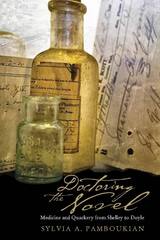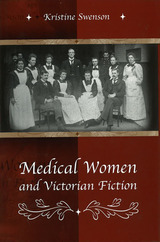2 books about Physicians in literature

Doctoring the Novel
Medicine and Quackery from Shelley to Doyle
Sylvia A. Pamboukian
Ohio University Press, 2012
If nineteenth-century Britain witnessed the rise of medical professionalism, it also witnessed rampant quackery. It is tempting to categorize historical practices as either orthodox or quack, but what did these terms really signify in medical and public circles at the time? How did they develop and evolve? What do they tell us about actual medical practices?
Doctoring the Novel explores the ways in which language constructs and stabilizes these slippery terms by examining medical quackery and orthodoxy in works such as Mary Shelley’s Frankenstein, Charles Dickens’s Bleak House and Little Dorrit, Charlotte Brontë’s Villette, Wilkie Collins’s Armadale, and Arthur Conan Doyle’s Stark Munro Letters. Contextualized in both medical and popular publishing, literary analysis reveals that even supposedly medico-scientific concepts such as orthodoxy and quackery evolve not in elite laboratories and bourgeois medical societies but in the rough-and-tumble of the public sphere, a view that acknowledges the considerable, and often underrated, influence of language on medical practices.
Doctoring the Novel explores the ways in which language constructs and stabilizes these slippery terms by examining medical quackery and orthodoxy in works such as Mary Shelley’s Frankenstein, Charles Dickens’s Bleak House and Little Dorrit, Charlotte Brontë’s Villette, Wilkie Collins’s Armadale, and Arthur Conan Doyle’s Stark Munro Letters. Contextualized in both medical and popular publishing, literary analysis reveals that even supposedly medico-scientific concepts such as orthodoxy and quackery evolve not in elite laboratories and bourgeois medical societies but in the rough-and-tumble of the public sphere, a view that acknowledges the considerable, and often underrated, influence of language on medical practices.
[more]

Medical Women and Victorian Fiction
Kristine Swenson
University of Missouri Press, 2005
In Medical Women and Victorian Fiction, Kristine Swenson explores the cultural intersections of fiction, feminism, and medicine during the second half of the nineteenth century in Britain and her colonies by looking at the complex and reciprocal relationship between women and medicine in Victorian culture. Her examination centers around two distinct though related figures: the Nightingale nurse and the New Woman doctor. The medical women in the fiction of Elizabeth Gaskell (Ruth), Wilkie Collins (The Woman in White), Dr. Margaret Todd (Mona McLean, Medical Student), Hilda Gregg (Peace with Honour), and others are analyzed in relation to nonfictional discussions of nurses and women doctors in medical publications, nursing tracts, feminist histories, and newspapers.
Victorian anxieties over sexuality, disease, and moral corruption came together most persistently around the figure of a prostitute. However, Swenson takes as her focus for this volume an opposing figure, the medical woman, whom Victorians deployed to combat these social ills. As symbols of traditional female morality informed and transformed by the new social and medical sciences, representations of medical women influenced public debate surrounding women’s education and employment, the Contagious Diseases Acts, and the health of the empire.
At the same time, the presence of these educated, independent women, who received payment for performing tasks traditionally assigned to domestic women or servants, inevitably altered the meaning of womanhood and the positions of other women in Victorian culture. Swenson challenges more conventional histories of the rise of the actual nurse and the woman doctor by treating as equally important the development of cultural representations of these figures.
[more]
READERS
Browse our collection.
PUBLISHERS
See BiblioVault's publisher services.
STUDENT SERVICES
Files for college accessibility offices.
UChicago Accessibility Resources
home | accessibility | search | about | contact us
BiblioVault ® 2001 - 2024
The University of Chicago Press









